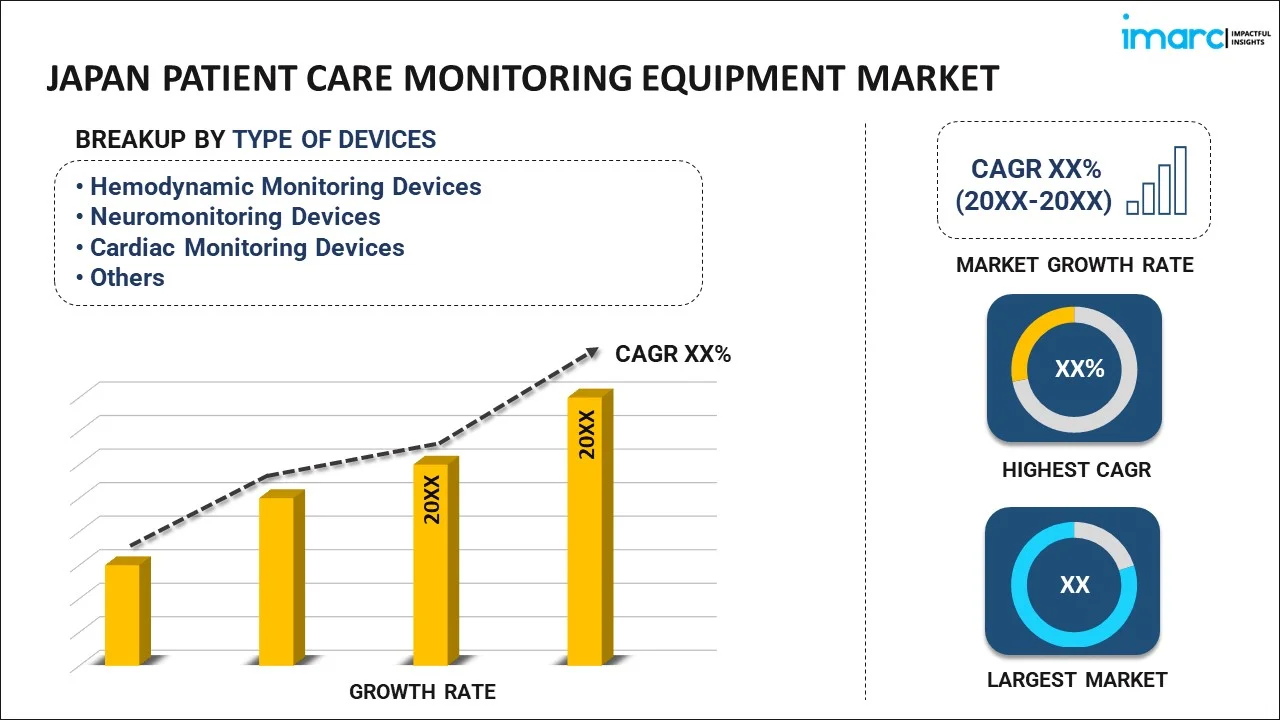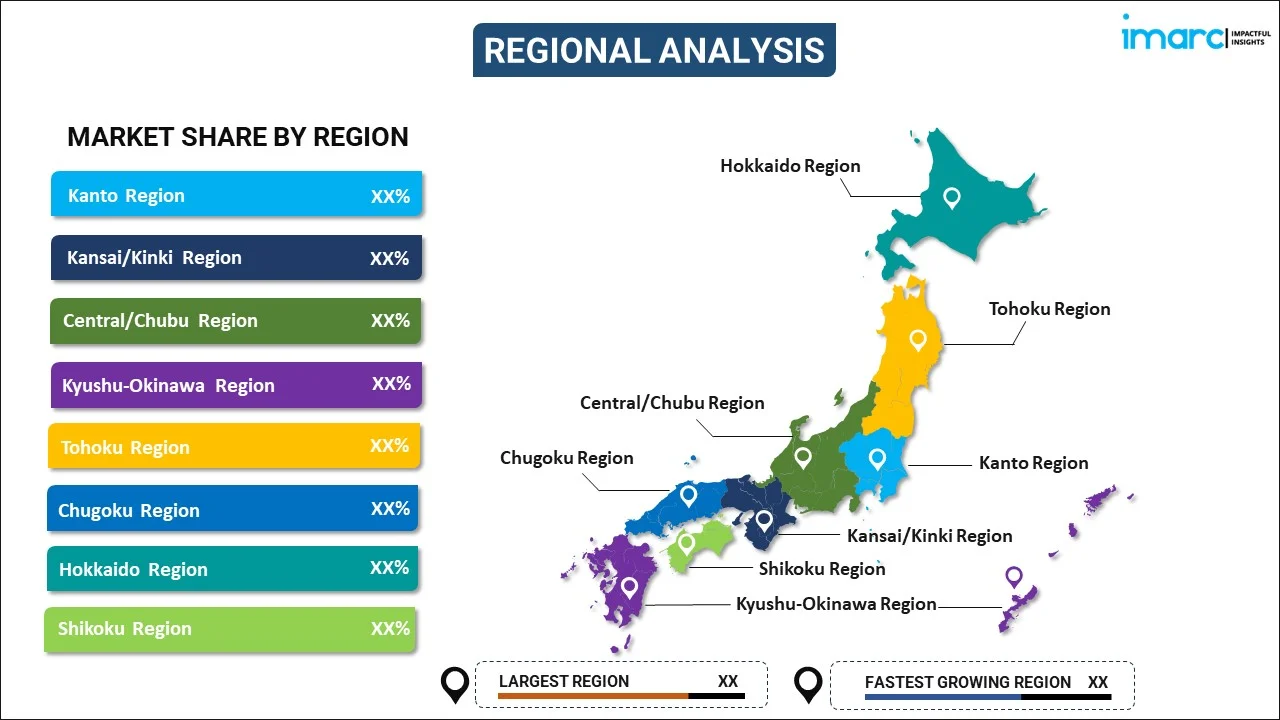
Japan Patient Care Monitoring Equipment Market Report by Type of Device (Hemodynamic Monitoring Devices, Neuromonitoring Devices, Cardiac Monitoring Devices, Multi-parameter Monitors, Respiratory Monitoring Devices, Remote Patient Monitoring Devices, and Others), Application (Cardiology, Neurology, Respiratory, Fetal and Neonatal, Weight Management and Fitness Monitoring, and Others), End User (Home Healthcare, Hospitals and Clinics, and Others), and Region 2025-2033
Market Overview:
Japan patient care monitoring equipment market size reached USD 1.9 Billion in 2024. Looking forward, IMARC Group expects the market to reach USD 3.9 Billion by 2033, exhibiting a growth rate (CAGR) of 7.8% during 2025-2033. The increasing emphasis on home-based care, along with the rising need for facilitating remote consultations and continuous monitoring irrespective of geographical constraints, is primarily augmenting the market growth.
|
Report Attribute
|
Key Statistics
|
|---|---|
|
Base Year
|
2024
|
|
Forecast Years
|
2025-2033
|
|
Historical Years
|
2019-2024
|
|
Market Size in 2024
|
USD 1.9 Billion |
|
Market Forecast in 2033
|
USD 3.9 Billion |
| Market Growth Rate 2025-2033 | 7.8% |
Patient care monitoring equipment plays an indispensable role in modern healthcare, serving as the eyes and ears of clinicians in various settings. These devices, ranging from vital sign monitors to advanced telemetry systems, provide real-time insights into a patient's physiological status, ensuring timely interventions and optimal care outcomes. The importance of these tools cannot be overstated, especially in critical care environments where split-second decisions can be the difference between life and death. Beyond the immediacy of hospital settings, such equipment is also becoming increasingly relevant in home care scenarios, enabling remote monitoring and telehealth capabilities. As medical technology continues to evolve, these devices are becoming more sophisticated, integrating advanced sensors, wireless connectivity, and data analytics.
Japan Patient Care Monitoring Equipment Market Trends:
The Japan patient care monitoring equipment market holds a prominent position within the country's advanced healthcare ecosystem, shaped by a blend of technological prowess and a proactive approach to patient well-being. One major driver is the increasing demand for home-based and remote healthcare solutions. As the country grapples with a rising elderly population, there's a noticeable shift towards home care, necessitating devices that allow seamless remote monitoring and timely interventions. The integration of AI and IoT in medical devices is another trend shaping the market. Modern monitoring equipment is now equipped with smart sensors and algorithms that not only track health metrics but also predict potential health anomalies, enabling preventive care. Additionally, the rise of telemedicine, accelerated by the recent global health challenges, has further fueled the demand for advanced patient care monitoring tools. These devices enable healthcare professionals to consult, diagnose, and monitor patients from afar, ensuring continuous care despite physical barriers. Furthermore, Japan's robust regulatory framework and emphasis on quality assurance ensure that monitoring devices adhere to the highest safety and functionality standards. In essence, the confluence of demographic challenges, technological advancements, and a forward-thinking healthcare approach positions the Japan patient care monitoring equipment market for significant growth and innovation in the coming years.
Japan Patient Care Monitoring Equipment Market Segmentation:
IMARC Group provides an analysis of the key trends in each segment of the market, along with forecasts at the country level for 2025-2033. Our report has categorized the market based on type of device, application, and end user.
Type of Device Insights:

- Hemodynamic Monitoring Devices
- Neuromonitoring Devices
- Cardiac Monitoring Devices
- Multi-parameter Monitors
- Respiratory Monitoring Devices
- Remote Patient Monitoring Devices
- Others
The report has provided a detailed breakup and analysis of the market based on the type of device. This includes hemodynamic monitoring devices, neuromonitoring devices, cardiac monitoring devices, multi-parameter monitors, respiratory monitoring devices, remote patient monitoring devices, and others.
Application Insights:
- Cardiology
- Neurology
- Respiratory
- Fetal and Neonatal
- Weight Management and Fitness Monitoring
- Others
A detailed breakup and analysis of the market based on the application have also been provided in the report. This includes cardiology, neurology, respiratory, fetal and neonatal, weight management and fitness monitoring, and others.
End User Insights:
- Home Healthcare
- Hospitals and Clinics
- Others
The report has provided a detailed breakup and analysis of the market based on the end user. This includes home healthcare, hospitals and clinics, and others.
Regional Insights:

- Kanto Region
- Kansai/Kinki Region
- Central/ Chubu Region
- Kyushu-Okinawa Region
- Tohoku Region
- Chugoku Region
- Hokkaido Region
- Shikoku Region
The report has also provided a comprehensive analysis of all the major regional markets, which include Kanto Region, Kansai/Kinki Region, Central/ Chubu Region, Kyushu-Okinawa Region, Tohoku Region, Chugoku Region, Hokkaido Region, and Shikoku Region.
Competitive Landscape:
The market research report has also provided a comprehensive analysis of the competitive landscape. Competitive analysis such as market structure, key player positioning, top winning strategies, competitive dashboard, and company evaluation quadrant has been covered in the report. Also, detailed profiles of all major companies have been provided.
Japan Patient Care Monitoring Equipment Market Report Coverage:
| Report Features | Details |
|---|---|
| Base Year of the Analysis | 2024 |
| Historical Period | 2019-2024 |
| Forecast Period | 2025-2033 |
| Units | Billion USD |
| Scope of the Report | Exploration of Historical and Forecast Trends, Industry Catalysts and Challenges, Segment-Wise Historical and Predictive Market Assessment:
|
| Type of Devices Covered | Hemodynamic Monitoring Devices, Neuromonitoring Devices, Cardiac Monitoring Devices, Multi-parameter Monitors, Respiratory Monitoring Devices, Remote Patient Monitoring Devices, Others |
| Applications Covered | Cardiology, Neurology, Respiratory, Fetal and Neonatal, Weight Management and Fitness Monitoring, Others |
| End Users Covered | Home Healthcare, Hospitals and Clinics, Others |
| Regions Covered | Kanto Region, Kansai/Kinki Region, Central/ Chubu Region, Kyushu-Okinawa Region, Tohoku Region, Chugoku Region, Hokkaido Region, Shikoku Region |
| Customization Scope | 10% Free Customization |
| Post-Sale Analyst Support | 10-12 Weeks |
| Delivery Format | PDF and Excel through Email (We can also provide the editable version of the report in PPT/Word format on special request) |
Key Questions Answered in This Report:
- How has the Japan patient care monitoring equipment market performed so far and how will it perform in the coming years?
- What has been the impact of COVID-19 on the Japan patient care monitoring equipment market?
- What is the breakup of the Japan patient care monitoring equipment market on the basis of type of device?
- What is the breakup of the Japan patient care monitoring equipment market on the basis of application?
- What is the breakup of the Japan patient care monitoring equipment market on the basis of end user?
- What are the various stages in the value chain of the Japan patient care monitoring equipment market?
- What are the key driving factors and challenges in the Japan patient care monitoring equipment?
- What is the structure of the Japan patient care monitoring equipment market and who are the key players?
- What is the degree of competition in the Japan patient care monitoring equipment market?
Key Benefits for Stakeholders:
- IMARC’s industry report offers a comprehensive quantitative analysis of various market segments, historical and current market trends, market forecasts, and dynamics of the Japan patient care monitoring equipment market from 2019-2033.
- The research report provides the latest information on the market drivers, challenges, and opportunities in the Japan patient care monitoring equipment market.
- Porter's five forces analysis assist stakeholders in assessing the impact of new entrants, competitive rivalry, supplier power, buyer power, and the threat of substitution. It helps stakeholders to analyze the level of competition within the Japan patient care monitoring equipment industry and its attractiveness.
- Competitive landscape allows stakeholders to understand their competitive environment and provides an insight into the current positions of key players in the market.
Need more help?
- Speak to our experienced analysts for insights on the current market scenarios.
- Include additional segments and countries to customize the report as per your requirement.
- Gain an unparalleled competitive advantage in your domain by understanding how to utilize the report and positively impacting your operations and revenue.
- For further assistance, please connect with our analysts.
 Inquire Before Buying
Inquire Before Buying
 Speak to an Analyst
Speak to an Analyst
 Request Brochure
Request Brochure
 Request Customization
Request Customization




.webp)




.webp)












